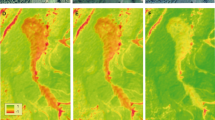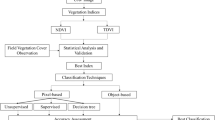Abstract
To both collect terrain data rapidly and save labor costs, the present study employs high-spatiotemporal-resolution imaging through Formosat-2 and aerial photography through unmanned aerial vehicles. In daily visits to the same area, images taken by Formosat-2 can be employed as data for long-term observation. Unclouded images from 2006 to 2010 processed with a false-color overlay and calculated of the normalized difference vegetation index are selected as terrain data. Aerial photos taken by unmanned aerial vehicles are utilized ground-truth data. These two types of data are analyzed to proceed with supervised classification. The results reveal that in the study area mangroves are the most exuberant in summer. The growth of mangroves in Sihcao Wetland remained in dynamic equilibrium from 2006 to 2010 without any sharp increase or decrease in quantity. This proposed method is believed to be suitable to investigate and preserve mangroves by long-term image monitoring and to avoid any unnatural influence on these conservation areas.

Similar content being viewed by others
References
Aschbacher J, Ofren R, Delsol JP, Suselo TB, Vibulsresth S, Charrupat T (1995) An integrated comparative approach to mangrove vegetation mapping using advanced remote sensing and GIS technologies. Hydrobiologia 295:285–294
Bhattarai B, Giri C (2011) Assessment of mangrove forests in the Pacific region using Landsat imagery. J Appl Remote Sens 5:053509
Gang PO, Agatsiva JL (1992) The current status of mangroves along the Kenyan coast: a case study of Misa Creek mangroves based on remote sensing. Hydrobiologia 247:29–36
ISEM (2012) http://www.mangrove.or.jp/isme/english/index.htm
Lin ML (2011) Using GIS-based spatial geocomputation from remotely sensed data for drought risk-sensitive assessment. Int J Innov Comput Inf Control 7(2):657–668
Lin CW (2012) The construction of a high-resolution visual monitoring for hazard analysis. Nat Hazards. doi:10.1007/s11069-012-0409-9
Liu CC (2006) Processing of FORMOSAT-2 daily revisit imagery for site surveillance. IEEE Trans Geosci Remote Sens 44:3206–3214
Long JB, Giri C (2011) Mapping the Philippines’ Mangrove Forests using landsat imagery. Sensors 11:2972–2981
Metternicht G (2003) Vegetation indices derived from high-resolution airborne videography for precision crop management. Int J Remote Sens 24(14):2855–2877
Taijiang National Park (2012) http://www.tjnp.gov.tw/
Wang TY, Chen JC, Chen CT (2006) Using SPOT satellite image to study the variation of vegetation index for Tamsui river mangrove natural reserve. Crop Environ Bioinform 3(3):229–238
Wu AM, Lee YY, Kuo P, Kao R (2003) ROCSAT-2 imaging planning and scheduling. In: The first Taipei international conference on digital earth, Taipei, Taiwan
Acknowledgments
The authors would like to thank the National Science Council of the Republic of China, Taiwan, for their financial support of this research under Contract Nos. NSC 101-2627-B-006-013, NSC 101-2611-M-006-002, and 100-2628-E-022-002-MY2.
Author information
Authors and Affiliations
Corresponding author
Rights and permissions
About this article
Cite this article
Liu, C.C., Chen, Y.Y. & Chen, C.W. Application of multi-scale remote sensing imagery to detection and hazard analysis. Nat Hazards 65, 2241–2252 (2013). https://doi.org/10.1007/s11069-012-0472-2
Received:
Accepted:
Published:
Issue Date:
DOI: https://doi.org/10.1007/s11069-012-0472-2




